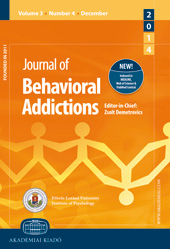Commentary on: Are we overpathologizing everyday life? A tenable blueprint for behavioral addiction research. On the slippery slopes: The case of gambling addiction
Commentary on: Are we overpathologizing everyday life? A tenable blueprint for behavioral addiction research. On the slippery slopes: The case of gambling addiction
Author(s): Luke ClarkSubject(s): Cognitive Psychology, Neuropsychology, Personality Psychology, Behaviorism, Substance abuse and addiction, Social Informatics
Published by: Akadémiai Kiadó
Keywords: pathological gambling; video games; addiction; tolerance; neuroimaging; structural features;
Summary/Abstract: Billieux et al. (2015) propose that the recent proliferation of behavioral addictions has been driven by deficiencies in the underlying research strategy. This commentary considers how pathological gambling (now termed gambling disorder) traversed these challenges to become the first recognized behavioral addiction in the DSM-5. Ironically, many similar issues continue to exist in research on gambling disorder, including question-marks over the validity of tolerance, heterogeneity in gambling motives, and the under-specification of neuroimaging biomarkers. Nevertheless, I contend that the case for gambling disorder as a behavioral addiction has been bolstered by the existence of clear and consistent functional impairment (primarily in the form of debt), coupled with the development of a public health approach that has given emphasis to product features (i.e. the structural characteristics of gambling forms) as much as individual dispositions (the ‘addictive personality’).
Journal: Journal of Behavioral Addictions
- Issue Year: 4/2015
- Issue No: 3
- Page Range: 132-134
- Page Count: 3
- Language: English

